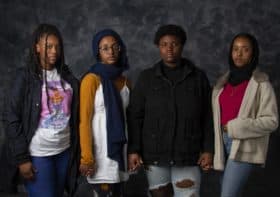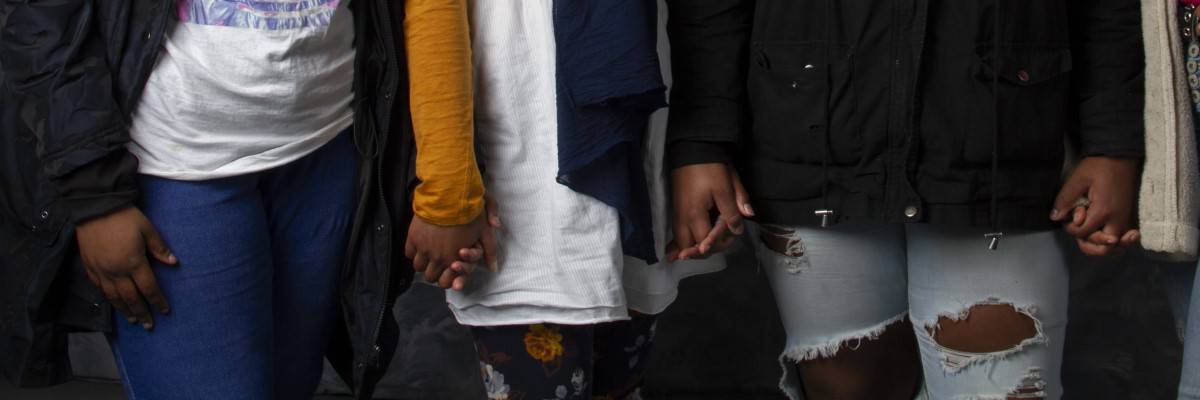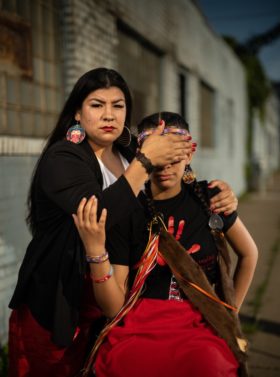Minneapolis students reflect on race and identity through It’s the People art project

A group of Minneapolis high school students has spent the last year exploring the concept of identity through portrait photography. They found that their own sense of identity has shifted as the world has changed around them in visible — and sometimes violent — ways.
“Everyone should know what their identity is,” says Hannah Washington, a student at the FAIR School in downtown Minneapolis. “I feel like everyone should have a representation that relates to their identity.”

Left to right: Hannah Washington, Faaya Adem, T’Aaliyah Smith, Masnoo Adem. Photo by Tre’Von Calaway.
Hannah is one of a group of students from the FAIR School who participated in It’s the People, a public art project by Hennepin Theatre Trust. The project uses portraiture to capture the heart and soul of the people whose experiences and stories create the unique vibrancy of Hennepin Avenue. The above photo is part of the project, taken by FAIR School student Tre’Von Calaway and featuring his classmates. You can see more student photos on the It’s the People page on Youth identity.
The students worked with professional photographer and professor Kristine Heykants to learn about the concepts and techniques of portrait photography. She led photography workshops in February and March 2020, just before Minnesota went into lockdown during the COVID-19 pandemic. At the time, Heykants challenged the students to think about what is important to them in terms of who they are.
Reflecting four months later
Four months after the photography workshops — and only a few weeks after the killing of George Floyd just three miles from their school — Heykants held a conversation with three of the students featured in the above photo. She asked them what emotions came up for them when they look at the photo.
They say that they held hands because T’Aaliyah Smith, also shown in the photo, thought it would look nice. But now, they believe it sends a strong message of solidarity.
“When I first look at it, you obviously see Black women, but you also see strong Black women,” says student Faaya Adem. “[There is] this push for Black women to always be strong, but you can notice how we’re supporting each other by how we’re holding hands, how we’re facing toward each other.”
Hannah adds, “How we’re holding hands, meaning that we’re unified together. A lot of times, people like to pit Black women against each other, but when you see this, we’re standing together… For girls, Black women, to stand together like that and holding hands in solidarity, I think it’s a good picture and a good message, especially in today’s world.”

Shifting view on identity
Heykants also asked the students if anything about their view of their own identities has changed. A year ago, all three had the same answer about the most important aspect of their identity: religion. Now, they say they have a broader view.
“I feel like my religion is a very visible part of my identity,” said Masnoo Adem, seen on the left in the portrait. “When you look at me, you’re like ‘Oh yeah, she’s Muslim; she wears a hijab.’ But I think that [recently] it’s become very clear that my racial identity is very important and also stands out as well, because I am a Black Muslim woman.”
Hannah shared a similar sentiment. “I grew up in a Christian household, so the religious aspect was a big part of my life,” she says, “but it’s definitely racial now, because with the murder of George Floyd, you see how the Black race is just really tired, and it makes you really see how your race can effect so much of your life.”
Faaya added that religion and race have both always been important to her.
“I feel like since I was a kid, my racial identity and my Blackness has been something for me,” she says. “I had the privilege of going to an all-white school for a very long time, so I feel like I had a lot of time to explore my identity as a Black person. Now with the murder of George Floyd, I’ve had more time because we’re not in school and I have all this free time at home.”
The girls say they felt a lot of emotions surrounding the death of George Floyd and the protests that followed.
“Even though it wasn’t me who got shot or anyone in my family, it was someone from my community,” said Hannah. “Our community is tired. We can only peaceful protest for so much. I feel like we’ve gotten to a point where we do need to start riots and do all of this because it seems like the only way we have your attention. [Our] photo showed how we need to be together right now, instead of being divided.”
Masnoo says she is hopeful. “It’s just a lot of emotions, but a lot of positive things have come out of this as well. And I feel with the protests, a lot of positive change will come that’s needed.”
Hannah is more cautious. ” I don’t know how many years we’ve been protesting,” she says. “I want to be hopeful, but I just get scared that nothing will change.”
It’s the People Virtual Roundtable with photographer Kristine Heykants

It’s the People portrait by Chad Germann
Art and emotion
Art has been an important tool to help process these complicated emotions.
“I would say we wanted to take a picture that says something,” says Hannah. “We just wanted people to look at our picture and see what comes to their mind when they see it. It shouldn’t all be the same.”
The students’ portraits are part of It’s the People. Other photos in the project were taken by renowned Minnesota artists and showcase the themes of empowerment, trans equity, community outreach through violence prevention, and social justice for missing and murdered Indigenous women and girls. The images are displayed on Clear Channel Outdoor billboards across the region and street pole banners that line Hennepin Avenue. Hear more from Heykants and the students and other artists in our It’s the People Virtual Rountable series.
Thanks to our supporters, we are able to instill confidence and community connection in more than 8,000 students statewide through our arts education programs, elevate and financially support the creative works of local artists and provide meaningful arts and cultural experiences to the more than 600,000 people we bring to the Hennepin Theatre District annually. When you make a gift to Hennepin Theatre Trust, you are enabling cultural and economic vitality to flourish statewide. Please support the arts by giving a donation.